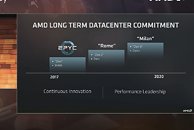Tuesday, May 16th 2017

AMD to Continue Working With TSMC, GLOBALFOUNDRIES on 7 nm Ryzen
In the Q&A section of their 2017 Financial Analyst Day, AMD CEO Lisa Su answered an enquiry from a Deutsche-bank questioner regarding the company's aggressive 7 nm plan for their roadmap, on which AMD seems to be balancing its process shrinkage outlook for the foreseeable future. AMD will be developing their next Zen architecture revisions on 7 nm, alongside a push for 7 nm on their next-generation (or is that next-next generation?) Navi architecture. This means al of AMD's products, consumer, enterprise, and graphics, will be eventually built on this node. This is particularly interesting considering AMD's position with GLOBALFOUNDRIES, with which AMD has already had many amendments to their Wafer Supply Agreement, a remain of AMD's silicon production division spin-off, the latest of which runs from 2016 to 2020.
As it is, AMD has to pay GLOBALFOUNDRIES for its wafer orders that go to other silicon producers (in this case, TSMC), in a quarterly basis since the beginning of 2017, based on the volume of certain wafers purchased from another wafer foundry. In addition, AMD has annual wafer purchase targets from 2016 through the end of 2020, fixed wafer prices for 2016, and a framework for yearly wafer pricing in this amendment, so the company is still bleeding money to GLOBALFOUNDRIES. However, AMD is making the correct decision in this instance, I'd wager, considering GLOBALFOUNDRIES' known difficulties in delivering their process nodes absent of quirks.
As it is, AMD has to pay GLOBALFOUNDRIES for its wafer orders that go to other silicon producers (in this case, TSMC), in a quarterly basis since the beginning of 2017, based on the volume of certain wafers purchased from another wafer foundry. In addition, AMD has annual wafer purchase targets from 2016 through the end of 2020, fixed wafer prices for 2016, and a framework for yearly wafer pricing in this amendment, so the company is still bleeding money to GLOBALFOUNDRIES. However, AMD is making the correct decision in this instance, I'd wager, considering GLOBALFOUNDRIES' known difficulties in delivering their process nodes absent of quirks.



12 Comments on AMD to Continue Working With TSMC, GLOBALFOUNDRIES on 7 nm Ryzen
5nm was mentioned in the context when quantum tunneling effects jump in (jeopardizing the costs) so it is often regarded as "end of the Moor's law" mark.
But yeah, kinda crazy to consider that we're maybe five years off from the physical limits to how small we can shrink silicon.